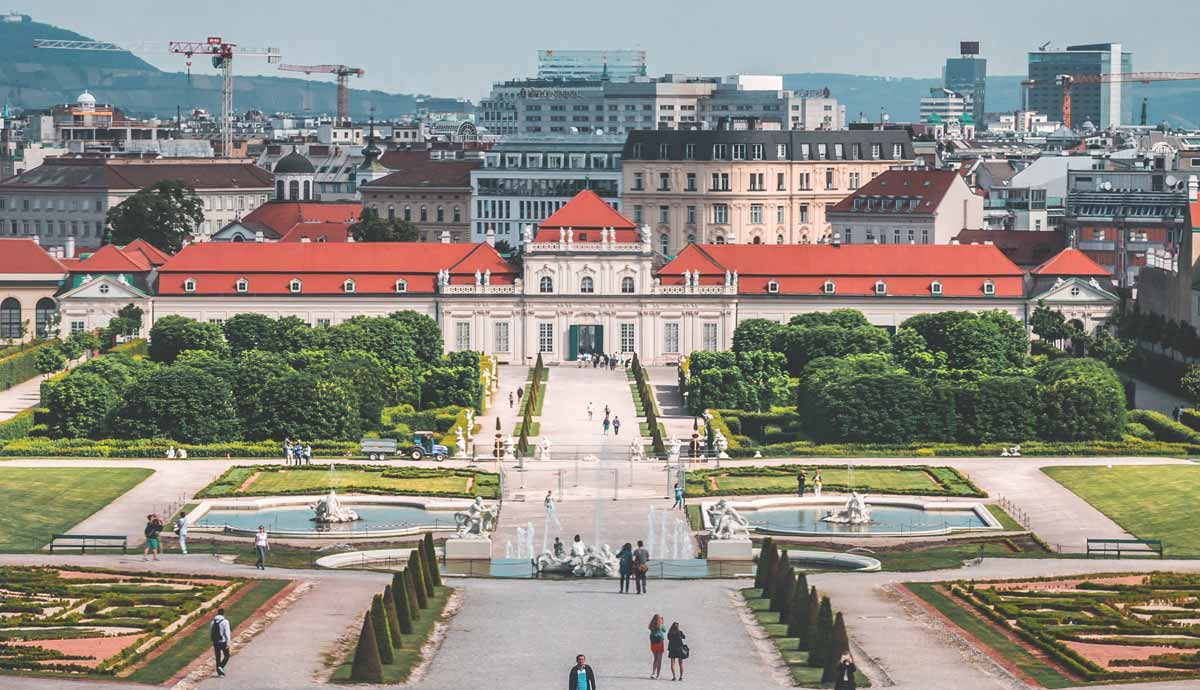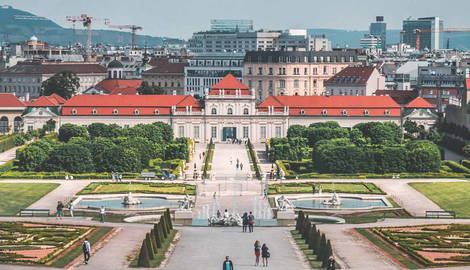
On the first Saturday in October every year, Vienna hosts a unique and thrilling event, the Long Night of Museums. On this day, over a hundred Vienna museums invite thousands of curious visitors to indulge in their collections as the evening draws in. Choosing which venues to visit is almost impossible, but we’ve done the hard work for you, and covered the most noteworthy museums worth seeing during this exciting and eventful occasion.
The Long Night of Museums
One ticket allows access to over a hundred museums in Vienna, open from 6 p.m. up to 1 a.m. The ticket is available at any museum or ticket point across the city. In addition to permanent collections, many plan exclusive and memorable events for the night. These include workshops, live performances, and interactive demonstrations. Since it’s a popular event attracting many tourists and residents, the city helps out by providing free shuttle buses.
The Belvedere

One of the most stunning palaces in Vienna is the Belvedere. It’s a building complex consisting of two majestic Baroque palaces known as the Upper and Lower Belvedere. The complex also includes the Orangery and the Stables, used for cultural events and temporary art exhibitions. Gorgeous elegant gardens surround the palaces and are a favorite location for locals and tourists. The Belvedere, designed in the 18th century by the Austrian architect Johann Lukas von Hildebrandt, was the summer residence for Prince Eugene of Savoy.
He was a talented warrior who led several successful wars against the Ottoman Empire. While the Upper Belvedere was more of a representative venue, the Lower Belvedere was the Prince’s living quarters. Visitors can still enjoy marvelous rooms, with the Hall of Grotesque, the Marble Gallery, and the Golden Room being the most impressive.

The complex is currently functioning as a museum hosting an extraordinary collection of Austrian art from the Middle Ages to the modern day. It features the world’s most extensive collection of paintings by Gustav Klimt, including his best-known painting, The Kiss. The museum also houses works by Egon Schiele, Helene Funke, Vincent van Gogh, and Oskar Kokoschka. In addition, visitors can enjoy the adjacent Belvedere 21, a museum of Austrian contemporary art, film, and music.
The Vienna State Opera

The Vienna State Opera, or the Staatsoper, is one of the world’s most acclaimed opera houses. Home to outstanding performances, including operas, ballets, and classical concerts, the Vienna State Opera hosts about 350 performances each season. The opera house opened in 1869, designed in the Neo-Renaissance style by Eduard van der Nüll and August Sicard von Sicardsburg. After the building suffered damages during WWII, it underwent several restorations and reopened in 1955. The Vienna State Opera offers guided tours and performances specifically planned for the Long Night of Museums.
The opera guests can see the well-preserved lobby, marble staircase, the Tea Salon, the Gustav Mahler Hall, and the Schwind Foyer. The Gustav Mahler Hall, dedicated to the former director of the opera house, features textile paintings inspired by Mozart’s works. The Schwind Foyer houses 16 oil paintings by Schwind. While exploring the interior, travelers may notice incredible gold decorations, silk wallpapers, and an imposing 2500-pipe organ in the Organ Hall.
The Hofburg

One day wouldn’t likely be enough to tackle the Hofburg. Let alone one night when there’s also an opportunity to see hundreds of other Vienna museums. Yet, the Hofburg is a must-see attraction, which can be the highlight of the Long Night of the Museums with careful planning. The former residence of the rulers of the Habsburg dynasty and the center of political power, Hofburg dates back to the 13th century. Every ruler who resided there added their touch to the palace’s design, resulting in an intricate mix of styles like Gothic, Renaissance, Baroque, Rococo, and Classicism.
The complex houses several museums, big and small, but the most impressive are the Imperial Apartments and the Sisi Museum, dedicated to the life of Empress Elisabeth of Austria and Emperor Franz Joseph. In addition, there are enticing areas like the Imperial Treasury, the Royal Chapel, and the 16th-century Spanish Riding School. The parks and gardens, including the Burggarten and Volksgarten parks and the Butterfly House, are also a wonderful way to enjoy the outdoors. Yet, all these are best to explore on any other day in Vienna.
The Natural History Museum

The Natural History Museum opened in 1889 and is one of the most fabulous places to visit during Vienna’s Long Night of Museums. For the special occasion, the museum’s staff prepares shows and workshops with scientists presenting their objects. Visitors can check the laboratories, look through the telescopes, and enjoy a cocktail at the museum’s rooftop. The museum consists of 39 rooms with over 30 million objects on display, including minerals, fossils, animal specimens, and human skeletons.
In addition to the incredible Dinosaur Hall and a modern planetarium, the museum’s collection features some of the world’s most famous archaeological discoveries. One is The Venus of Willendorf, an almost 30,000-year-old relic found in 1908.
The Albertina

The Albertina is a must-see location in Vienna, especially on the Long Night of Museums. On this occasion, the museum’s most sacred pieces, otherwise rarely shown, meet the public eye. The Albertina is a palace built on the former fortification, the Augustinian Bastion. This beautiful building was the residence of Duke Albert of Saxen-Teschen and his wife, Duchess Maria Christina, later belonging to their grandchildren. The Duke was the one who started the museum’s collection together with Count Giacomo Durazzo. Today, the Albertina is on the list of the world’s most-visited museums. Initially opened to the public in 2008, it reopened as the Albertina Modern in 2020.
Inside the museum hides one of the world’s largest print rooms, home to over 60 thousand drawings and around a million old master prints. Visitors can enjoy masterpieces by big-name creators like Leonardo da Vinci, Michelangelo, Raphael, Pieter Bruegel the Elder, Monet, Picasso, and many others. The ticket to the museum allows access to the state rooms of the members of the Habsburg dynasty and both permanent and temporary collections.
The Kunsthistorisches Museum

The Kunsthistorisches Museum, a.k.a. the Museum of Art History, opened in 1891 on the initiative of Emperor Franz Joseph I. Today, it is one of the most breathtaking buildings in Vienna and the country’s largest art museum. The building, covered with marble, stucco, and murals, was designed to house the art collection of the Habsburgs. Nowadays, the collection has items from Ancient Egypt up to the late 18th century, and its main focus is on Renaissance and Baroque art. One of the museum’s highlights is the Chamber of Art and Wonders (or the Kunstkammer Vienna), filled with over 2000 items belonging to the imperial family.
Guests can visit the Cupola Cafe in the Cupola Hall for a special breakfast or dinner. In addition to the world’s biggest collection of art by the Flemish artist Pieter Bruegel the Elder, the museum features artworks by Rembrandt, Rubens, Velazquez, and other art geniuses.
The Vienna Museum of Science & Technology

The Vienna Museum of Technology is the #1 venue for technology buffs and a superb way to have fun for young and old. The museum offers a detailed look at humanity’s technological and scientific progress through interactive exhibits and hands-on experiences. The venue of over 20 thousand square meters takes visitors on an exciting journey using multimedia displays, 3D simulators, virtual reality, and other fun ways to explore.
The museum’s spaces provide insight into almost everything – from space exploration and a mining exhibit to basic household items. On The Long Night of Museums, there are plenty of inspiring events and engaging workshops. Children can enjoy a play area and a slide.
The Leopold Museum

The largest and the most popular in the MuseumsQuartier, the Leopold Museum is another enticing destination on Vienna’s Long Night of Museums. The museum, which opened in 2001, owes its design to talented architects Laurids and Manfred Ortner. The permanent collection of the museum, often enlivened by temporary exhibitions, comes mainly from the private collection of Elisabeth and Rudolf Leopold. There are paintings, drawings, and sculptures largely from the first half of the 20th century.
What makes the Leopold Museum so special is the world’s largest collection of works by Egon Schiele and an impressive selection of art by Gustav Klimt. Artists like Josef Hoffmann, Adolf Loos, and Otto Wagner have also found their place in the museum’s spaces. On the Long Night of Museums, people come to enjoy unique installations, live drawing performances, and stunning views from the MQ Libelle, the museum’s roof terrace.










